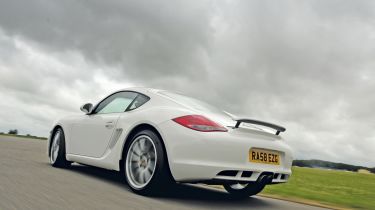Porsche Cayman PDK
Revisions have confirmed model as one of world’s best cars
Slotting into the range between the soft-top Boxster and legendary 911, the Cayman has twice been voted Auto Express Performance Car of the Year – and it’s one of the best in the business.
The shape follows Porsche’s family tradition and the complex curves over the rear wheelarches are a real highlight. While the bulbous roof isn’t universally popular, the twin-lens headlamps and LED tail-lights ensure the S oozes quality without resorting to a big rear wing or aggressive bodykit.
For a two-seat sports car it’s practical, too. The long tailgate opens to reveal a generous 260-litre boot, there’s a handy luggage net on top of the mid-mounted engine and a deep 150-litre space in the nose.
Inside, you get large carpet-lined stowage bins in the doors and, as in the TT, the driving position is perfect. The dash is a combination of modern quality and Porsche’s classic triple-dial layout. And thanks to the perfectly weighted controls you feel instantly at one with the Cayman.
Crucially, though, we’d stick with the manual gearbox – because the controls on our car’s twin-clutch PDK transmission are counter-intuitive, and the set-up isolates you from the driving experience. The box also kicks down, preventing you enjoying the 3.4-litre flat-six engine through its rev range. And this highlights the flexibility of the manual TT – it has 80Nm more torque.
Used - available now

2020 Peugeot
508
57,957 milesAutomaticDiesel1.5L
Cash £11,999
2021 Ford
Fiesta
9,955 milesAutomaticPetrol1.0L
Cash £16,699
2023 Ford
Puma
18,363 milesAutomaticPetrol1.0L
Cash £16,899
2020 Ford
Kuga
24,644 milesAutomaticDiesel2.0L
Cash £25,799The Porsche also has 20bhp less power than the Audi, and its flat-six engine only comes alive above 4,000rpm. In contrast, the TT is on song from as low as 3,000rpm. So, you need to work the Cayman hard –and that’s why the manual box is better.
Despite its power deficit, the Porsche never feels short of performance. It’s lighter than the TT – weighing 1,375kg to the Audi’s 1,450kg – and with its powerplant placed in the centre of the chassis, it has a dynamic advantage over the front-engined RS.
While the quattro system gives superb traction, the Cayman feels more agile and alive. Beautifully balanced handling makes it one of the most engaging cars at any price. It blends a rigid bodyshell and taut suspension with sharp steering, firm but delicate brakes and masses of grip. As
a result, it’s a joy to drive on any road; minimal body movement and peerless feedback make this an incredibly pure car.
We don’t have many criticisms, but the optional 19-inch wheels on our model gave more motorway tyre roar. Equipment is a bit miserly, too, although the £1,008 Porsche Active Suspension Management (PASM) system is impressive and provides similar ride comfort to the TT RS. The Porsche costs more than the Audi – so does it justify this?
Details
Chart position: 1
WHY: The Porsche is the sports car benchmark – but has it met its match in the shape of the four-wheel-drive Audi?







